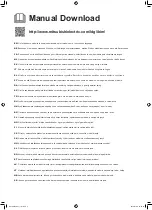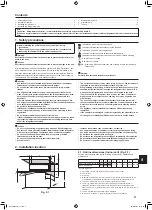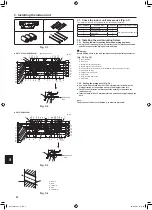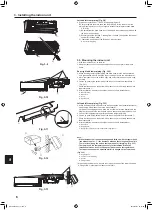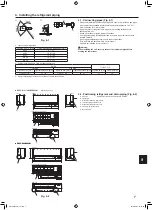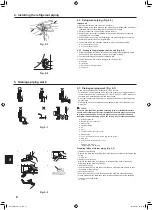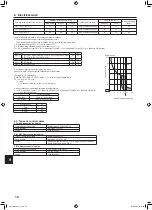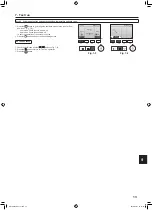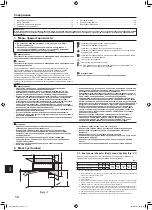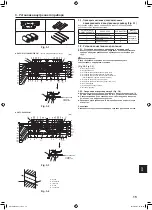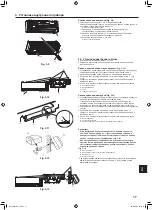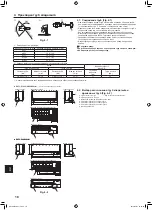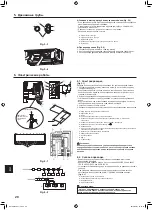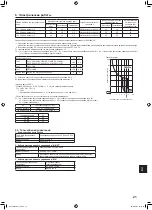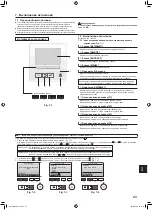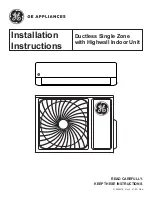
8
EN
4. Installing the refrigerant piping
Fig. 4-4
B
A
D
C
4.3. Refrigerant piping (Fig. 4-3)
Indoor unit
1. Remove the flare nut and cap of the indoor unit.
2. Make a flare for the liquid pipe and gas pipe and apply refrigerating machine oil
(available from your local supplier) to the flare sheet surface.
3. Quickly connect the on site cooling pipes to the unit.
4. Wrap the pipe cover that is attached to the gas pipe and make sure that the
connection join is not visible.
5. Wrap the pipe cover of the unit’s liquid pipe and make sure that it covers the
insulation material of the on site liquid pipe.
6. The portion where the insulation material is joined is sealed by taping.
A
Site-side refrigerant piping
B
Unit side refrigerant piping
4.3.1. Storing in the piping space of the unit (Fig. 4-4)
1. Wrap the supplied felt tape in the range of the refrigerant piping which will be
housed within the piping space of the unit to prevent dripping.
2. Overlap the felt tape at one-half of the tape width.
3. Fasten the end portion of the wrapping with vinyl tape, etc.
A
Gas pipe
B
Liquid pipe
C
Indoor/outdoor connection cable
D
Felt tape
3
Fig. 4-3
B
A
Fig. 5-1
5. Drainage piping work
A
B
C
E
D
C
F
C
G
H
I
J
K
5.1. Drainage piping work (Fig. 5-1)
• Drain pipes should have an inclination of 1/100 or more.
• For extension of the drain pipe, use a soft hose (inner dia. 15 mm) available on
the market or hard vinyl chloride pipe (VP-16/O.D. ø22 PVC TUBE). Make sure
that there is no water leakage from the connections.
• Do not put the drain piping directly in a drainage ditch where sulphuric gas may
be generated.
• When piping has been completed, check that water flows from the end of the
drain pipe.
Caution:
The drain pipe should be installed according to this Installation Manual to
ensure correct drainage. Thermal insulation of the drain pipes is necessary
to prevent condensation. If the drain pipes are not properly installed and
insulated, condensation may drip on the ceiling, floor or other possessions.
A
Inclined downwards
B
Must be lower than outlet point
C
Water leakage
D
Trapped drainage
E
Air
F
Wavy
G
The end of drain pipe is under water.
H
Drainage ditch
I
5 cm or less between the end of drain pipe and the ground.
J
Drain hose
K
Soft PVC hose (Inside diameter 15 mm)
or
Hard PVC pipe (VP-16)
* Bond with PVC type adhesive
Preparing left and left rear piping (Fig. 5-2)
1
Remove the drain cap.
• Remove the drain cap by holding the bit that sticks out at the end of the pipe and
pulling.
A
Drain cap
2
Remove the drain hose.
• Remove the drain hose by holding on to the base of the hose
a
(shown by
arrow) and pulling towards yourself
b
.
3
Insert the drain cap.
• Insert a screwdriver etc into the hole at the end of the pipe and be sure to push
to the base of the drain cap.
4
Insert the drain hose.
• Push the drain hose until it is at the base of the drain box connection outlet.
• Please make sure the drain hose hook is fastened properly over the extruding
drain box connection outlet.
B
Hooks
A
A
1
3
Fig. 5-2
a
b
A
B
2
4
RH79A015H01_en.indd 8
2019/02/01 16:14:05


